Hindsight’s 2020: Looking Back At Early COVID-19 Predictions And Warnings For Malta
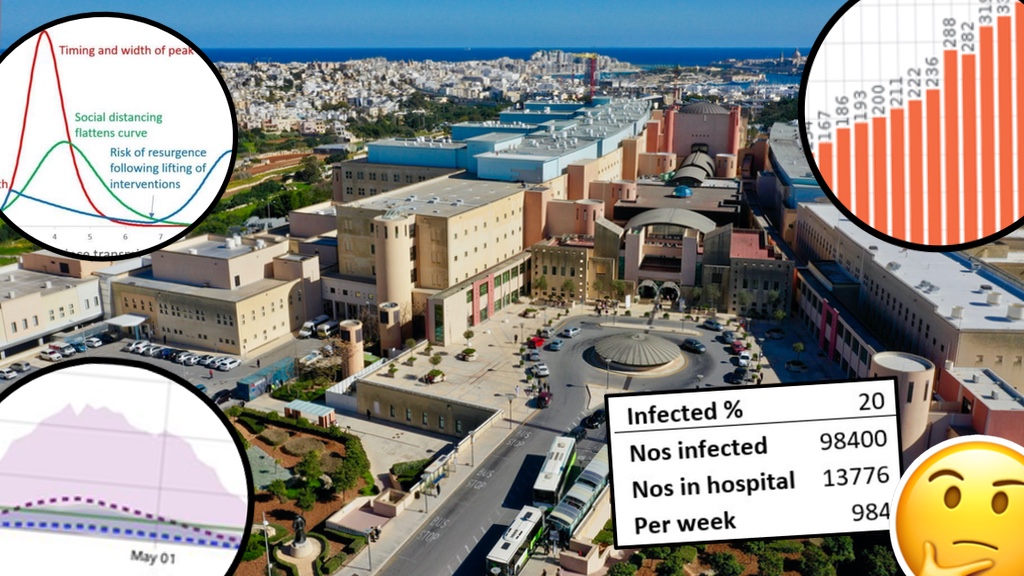
“Asking the question, ‘When will the peak be?’ is a bit of a silly question to ask,” University of Malta lecturer and actuary Dominic Cortis had written over a month ago. Despite that, of course, statistics and predictions have still proven to be important in warning the nation about the COVID-19 pandemic. But over two months into Malta’s first case, hindsight is now 20/20.
The nature and science of predictions has always been a fickle one. Even weather forecasts get it wrong sometimes, let alone those based on a never-bef0re-seen virus tearing its way through different cultures, climates and populations. However, it’s still an interesting thought experiment to look back and see what today’s situation looked like for yesterday’s predictions.
First, some present day context.
To this day, Malta has had 506 total confirmed cases of COVID-19.
There have been five deaths and 434 recoveries, which means 67 cases remain active.
For 24 days, Malta’s active cases of COVID-19 had been steadily dropping, before budging up again yesterday.
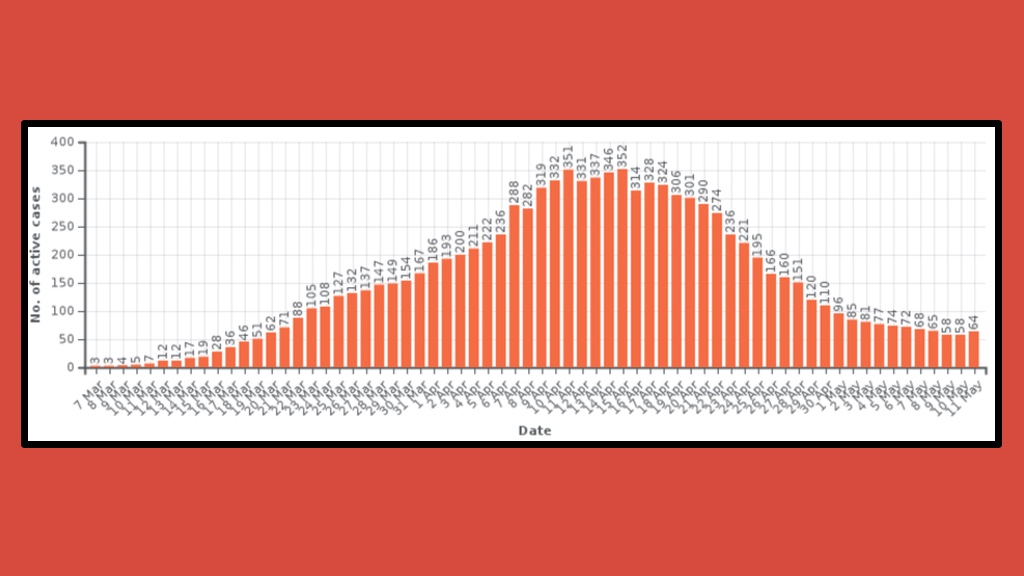
Malta's active COVID-19 cases as of yesterday, 11th May
So let’s start with the previously mentioned Dr. Dominic Cortis.
Back on 16th March, just nine days after Malta recorded its very first COVID-19 case, Cortis wrote up what was Times of Malta’s first article in a series looking at the pandemic from an actuarial perspective.
Actuaries are people who compile and analyse statistics, using them to calculcate insurance risks and premiums. In other words, a perfect resource to have if you’re trying to statistically predict something like this.
Of course, these being very early stages of the pandemic and Cortis himself admitting he’s not a healthcare expert put massive caveats in the prediction model that was “bound to be imperfect anyway”… but initial estimates were presented nonetheless.
Based on this model, by 23rd March, it was expected that Malta would have a total of 88 to 365 total cases, with the median being 180.
By 23rd March, the total number of COVID-19 cases in Malta hit that range, but thankfully fell way under the median, at 107.
Cortis also went on to expect “one to four more recoveries by Wednesday”, something which actually only happened over three weeks later, in early April.
“As for the number of deaths, hopefully none,” Cortis finished. So far, five people have died from COVID-19.
“Since no outcome is certain, there are bound to be some fluctuations in the daily number of cases,” Cortis had written a couple of weeks later, looking back at how some outlined predictions were harsher (Malta got 169 total cases by the end of March, as opposed to 187 should we have followed Singapore’s model) while others were actually generous (one week later, the Singapore model predicted 258 total cases, but Malta instead had 293).
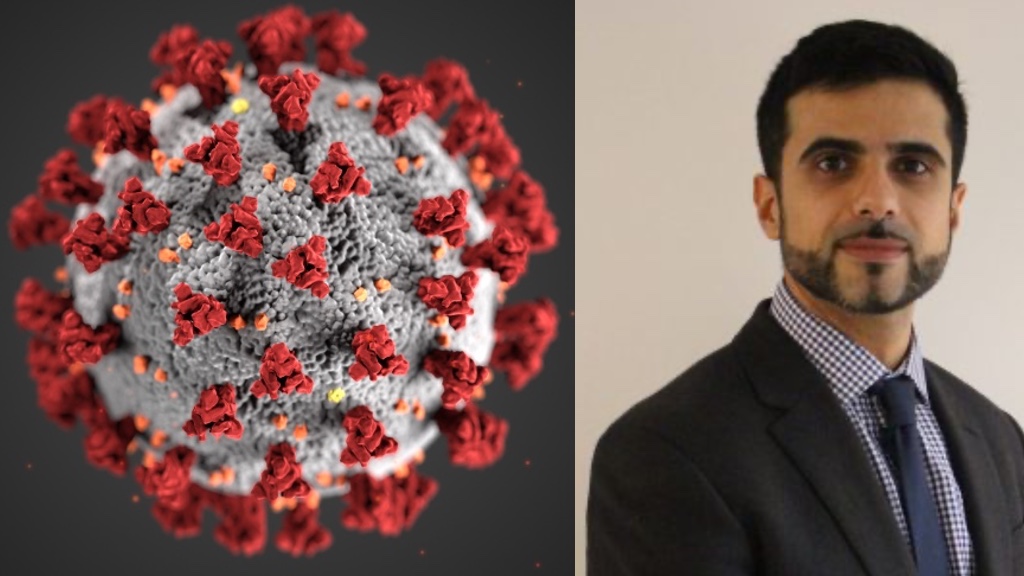
Well aware of fluctuations and accuracies, especially when trying to make predictions so early on, Dr. Cortis had presented a couple of cautious figures that weren't too far off the mark.
Another estimate, however, showed anywhere between 98,400 and 393,600 people being infected in Malta.
Professor Victor Grech, who helps run the paediatric cardiology services at Mater Dei Hospital and is also a researcher with an interest in epidemiology, has been keeping readers updated on everything COVID-19 on his blog.
Grech had also taken to some predictive charts and graphs back when the virus was only in Malta for just over a week, this time presenting bigger numbers courtesy of ballpark percentages to warn of worst-case scenarios.
Laying down four possible eventualities, Grech provided predictions for Malta based on infection rates of 20, 40, 60 and 80%.
Of course, while not inconceivable, the higher segments have still proven to be nearly worse-than-worst-case-scenario events around the world, so let’s look at the 20% range instead. This, after all, seems to have been based on Malta’s initial epidemic growth doubling time of 4 to 7 days.
Assuming Malta’s population is about half a million people and “an infection rate of ‘only’ 20%”, Grech’s graph kicks things off with 100,000 people becoming infected in the first 100 days, or about three months.
For that model to hold, about 99,500 people would need to be infected with COVID-19 in the next three weeks, as opposed to the 506 people infected in the last two odd months.
“If we manage to contain the spread so that ‘only’ 100,000 are infected over the course of 14 weeks, this equals 1,000 admissions a week and 350 intensive care admissions a week,” Grech had warned, in a statement that felt more like a warning than an actual prediction.
Of course, the models for infection rates higher than 20% are even more stark.
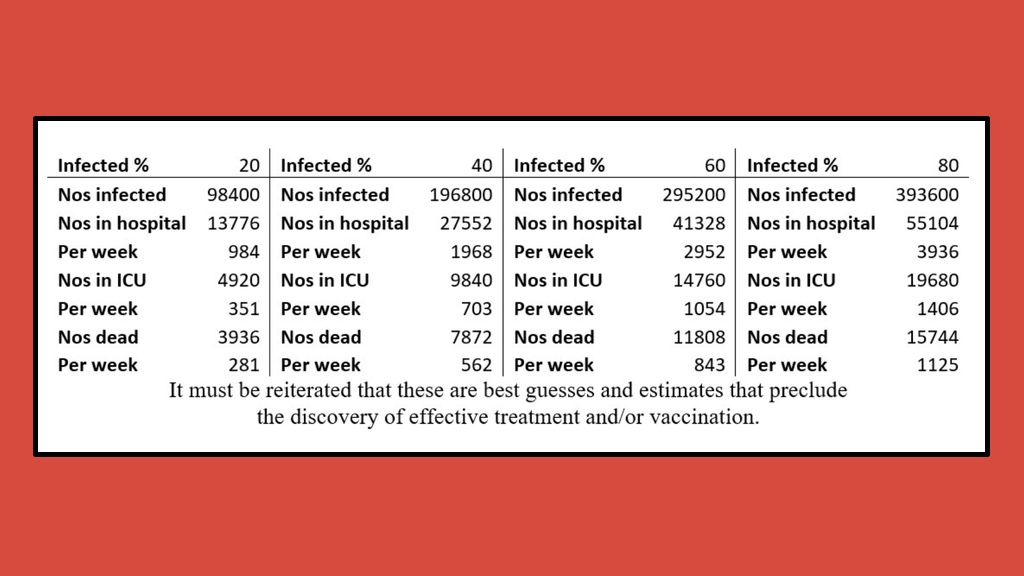
Four stark prediction models for Malta, based on infection rates of 20, 40, 60 and 80%
Interestingly, however, Grech had also gone on to highlight the potential dangers of announcing an official lockdown too early on, instantly pointing at the importance of social distancing the flatten the curve.
Now that Malta seems to have passed its inital curve peak, it’s also worth noting what Professor Grech had said of second waves.
“Disease spread is inevitable until a vaccine is available,” Grech had written back in mid-March, when Malta was still days into dealing with its initial COVID-19 cases. “Excessive measures early on may lead to a resurgence, i.e. a second and higher spike in infections.”
In a separate graph, this risk of resurgence following the lifting of interventions is also shown, and is predicted to be even higher than the first one.

"The blue curve represents a prematurely halted disease spread," Grech had explained back in March
Another important voice in all this has been Dr Frank Portelli, a former MP and owner of the St. Philip’s Hospital in Santa Venera.
Even before he offered to refurbish the former private hospital building within eight weeks and lease it out to the government for the treatment of COVID-19 patients on a non-profit basis in late March, Dr Portelli had been regularly going on TV and radio interviews to offer his expertise on the matter.
Taking to YouTube for everything from basic explainers to Q&A sessions, Portelli has been tackling the issue for the last two months now.
Portelli had quickly gone on record to warn against the dangers of herd immunity, saying getting some 300,000 people infected is incredibly dangerous. “We don’t even have that many people who are under 50 years of age,” he had warned. “You’re risking without even being sure that you’re protecting the elderly… because you just don’t have enough people in each age gap.”
“There were a lot of mistakes, and the first one was allowing these people to come into the country.”
Even a mere 10 days into Malta’s first case, Dr. Portelli had said the authorities should’ve done even more when it came to allowing people flying into the islands, especially from well-known hotspots like Italy, China and eventually Spain and Germany. One of his main points of contention with the authorities, however, was how, back in January, they had said there’s “a remote chance” of the virus ever arriving on our shores in the fist place.
Despite all this, Portelli is mostly satisfied with how things have panned out, but has reiterated that the battle isn’t over yet. “The longer this takes, the better,” he had said last month in an interview with NET Live. “It’s like we have a snake that we have managed to grab by the neck. We can’t relax that grip, because if we do that, it would only take one bite.”
Dr. Portelli’s prediction in mid-April was a hopeful one: if Malta keeps registering a steady flow of single-figure new cases, our healthcare system will cope.
Reminding everyone of the importance of flattening the curve and just what that actually meant – and how it would have to be a long-term outlook – Portelli said that the system’s only hope of coping is to keep daily new cases consistently under 10.
From the get-go, however, Dr. Portelli’s perspective has always been that it’s way more important to fear the virus than underestimate it.
“We need to fear it,” he sid. “First, we said it’s not likely to arrive in Malta. Now it’s here. And now it’s affecting people close to us.”
One month into Malta’s first case of COVID-19, Dr. Frank Portelli’s sister Rosalie died of the virus in a London hospital.
And what about the international prediction model most countries had started following from the get-go?
The Institute for Health Metrics and Evaluation (IHME) at the University of Washington’s School of Medicine has been quoted time and time again by numerous countries to try and predict what the COVID-19 situation would look like days, weeks and even months in the future… and Malta’s predictions were one mixed bag from the very beginning.
Back on 7th April, which was exactly one month into Malta’s first case of COVID-19, this newsroom had taken a snapshot of IHME’s predictions.
Predicting 19 total deaths by 4th August, the IHME had said Malta’s first death would arrive on 16th April, with peak resource use expected to arrive around 22nd April.
So how far off was this prediction?
Well, for starters, with three months to go until August, there have only been five deaths. The first death did arrive before 16th April, however, on the 8th. And, ironically, 16th April ended up being the day when Malta recorded its highest number of active cases (352), arguably proving to be a peak resource date.
Meanwhile, IHME’s prediction models foresaw seven invasive ventilators being needed… something which Malta has never gotten to half of yet.
Since then, Malta’s section on the IHME prediction tool – along with a number of other countries’ – has been removed.
The site is now not only focusing on specific hotspots like Italy, the UK and the US back at home, but is also breaking these countries down in different states and regions for more thorough analysis.
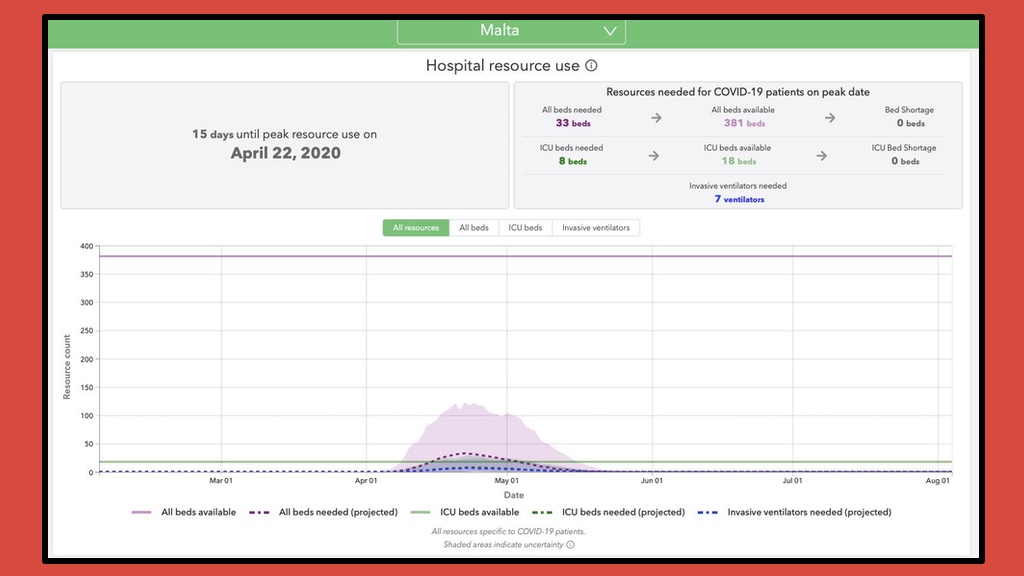
The IHME's predictions on Malta from 7th April